-
 Iron tsuba of round form adorned with the design of stars, wild geese, floating blossoms, leaves and tendrils realized in brass inlay. The inlay technique includes suemon-zōgan and ten-zōgan. Two smaller openings (hitsu-ana) surrounded by a scalloped brass border. The seppa-dai border inlay is missing, as well as a few other fragments of inlay on both sides. Sword cut at 12 o'clock on the reverse. A tsuba with a strong autumnal connotation, which once belonged to a great battle weapon. One of only three known jūyō Ōnin tsuba. Translation of the paper, issued by the Japanese sword fittings (tosogu) examination board: Designated as jūyō-tosogu at the 34th jūyō-shinsa held on April 14th 1988 Kaki-karimon zōgan-tsuba (花卉雁文象嵌鐔) — Tsuba with zōgan design of flowers and wild geese. Mumei: Onin (応仁) Tokyo. Nakasono Tokumi (中園とくみ) Measurements: height 9.5 cm, width 9.4 cm, thickness at rim 0.35 cm Interpretation: marugata, iron, brass zōgan, two hitsu-ana Time: end of Muromachi Explanation: Ōnin-tsuba are thin iron ita-tsuba which show a brass zōgan ornamentation. All of them are mumei and there is the theory that they were made in the Onin era (1467-1469) although today more and more the theory is accepted that they are in general late Muromachi period works. There are two kinds of brass zōgan interpretations: One depicts irregularly arranged tachibana branches, wild geese, chrysanthemums, flowers, or karakusa for example, and the other one shows punctual zōgan elements, which are referred to as hoshi-zōgan or ro-zōgan, and concentrical zōgan elements between the nakago-ana and the rim. The latter interpretations might also be accompanied by simple ko-sukashi in the form of butterflies, clouds, hats, or stylized mountains. This tsuba is a typical work from the former category. It is large and feels massive and the powerful and impressive zōgan and the excellent iron make it a highly tasteful piece. Back side: Issued to: Nakasono Tokumi Address: Tokyo-to, Suginami-ku, Kamitakaido 2-17-26 Date of issue: May 30th 1989
Iron tsuba of round form adorned with the design of stars, wild geese, floating blossoms, leaves and tendrils realized in brass inlay. The inlay technique includes suemon-zōgan and ten-zōgan. Two smaller openings (hitsu-ana) surrounded by a scalloped brass border. The seppa-dai border inlay is missing, as well as a few other fragments of inlay on both sides. Sword cut at 12 o'clock on the reverse. A tsuba with a strong autumnal connotation, which once belonged to a great battle weapon. One of only three known jūyō Ōnin tsuba. Translation of the paper, issued by the Japanese sword fittings (tosogu) examination board: Designated as jūyō-tosogu at the 34th jūyō-shinsa held on April 14th 1988 Kaki-karimon zōgan-tsuba (花卉雁文象嵌鐔) — Tsuba with zōgan design of flowers and wild geese. Mumei: Onin (応仁) Tokyo. Nakasono Tokumi (中園とくみ) Measurements: height 9.5 cm, width 9.4 cm, thickness at rim 0.35 cm Interpretation: marugata, iron, brass zōgan, two hitsu-ana Time: end of Muromachi Explanation: Ōnin-tsuba are thin iron ita-tsuba which show a brass zōgan ornamentation. All of them are mumei and there is the theory that they were made in the Onin era (1467-1469) although today more and more the theory is accepted that they are in general late Muromachi period works. There are two kinds of brass zōgan interpretations: One depicts irregularly arranged tachibana branches, wild geese, chrysanthemums, flowers, or karakusa for example, and the other one shows punctual zōgan elements, which are referred to as hoshi-zōgan or ro-zōgan, and concentrical zōgan elements between the nakago-ana and the rim. The latter interpretations might also be accompanied by simple ko-sukashi in the form of butterflies, clouds, hats, or stylized mountains. This tsuba is a typical work from the former category. It is large and feels massive and the powerful and impressive zōgan and the excellent iron make it a highly tasteful piece. Back side: Issued to: Nakasono Tokumi Address: Tokyo-to, Suginami-ku, Kamitakaido 2-17-26 Date of issue: May 30th 1989 -
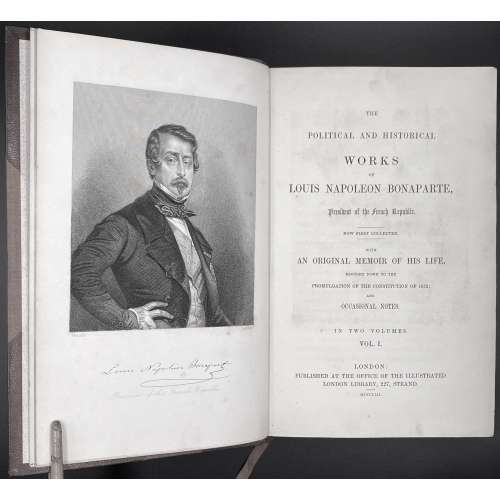 [Bonaparte, Louis Napoleon]. The Political and Historical Works of Louis Napoleon Bonaparte, President of the French Republic, Now First Collected With An Original Memoir of His Life, Brought Down to the Promulgation of the Constitution of 1852; and Occasional Notes, Complete in Two Volumes. London: Illustrated London Library, MDCCCLII [1852]. Collation: Vol. 1: [i-v] vi [vii-viii (blank)] [1] 2-462 [463,464 (blank)]; Vol. 2: [1-3] 4-439 [440]. Size: 22.8 x 14.8 cm (8vo), each. Binding: hardcover; half red morocco and cloth boards, five raised bands, gilt title and decoration, top edge gilt. Frontispiece portrait of Louis Napoleon Bonaparte in Vol. 1. Condition: Very good, rubbing to outer joints, leather corners, faint foxing to endpapers, ownership signature on half-title. Internally bright and unmarked. In binding by Brentano's, New York.
[Bonaparte, Louis Napoleon]. The Political and Historical Works of Louis Napoleon Bonaparte, President of the French Republic, Now First Collected With An Original Memoir of His Life, Brought Down to the Promulgation of the Constitution of 1852; and Occasional Notes, Complete in Two Volumes. London: Illustrated London Library, MDCCCLII [1852]. Collation: Vol. 1: [i-v] vi [vii-viii (blank)] [1] 2-462 [463,464 (blank)]; Vol. 2: [1-3] 4-439 [440]. Size: 22.8 x 14.8 cm (8vo), each. Binding: hardcover; half red morocco and cloth boards, five raised bands, gilt title and decoration, top edge gilt. Frontispiece portrait of Louis Napoleon Bonaparte in Vol. 1. Condition: Very good, rubbing to outer joints, leather corners, faint foxing to endpapers, ownership signature on half-title. Internally bright and unmarked. In binding by Brentano's, New York. -
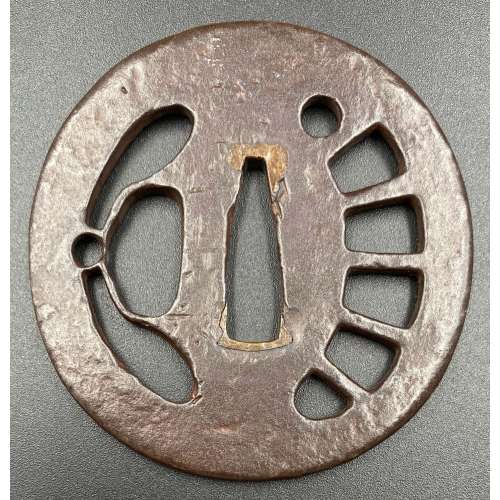
Oblong round shape (nagamaru-gata) tsuba with design of dragonfly (tombo or katsumushi) and wheel (kuruma) in negative openwork (kage-sukashi), round rim (maru-mimi ). Copper sekigane.
Okamoto Yasukazu's Owari to Mikawa no tankō, №181 characterizes the tsuba as follows: "Katsumushi, kuruma-sukashi no zu (dragonfly and wheel sukashi). Mei: Yamakichibei (Shodai). Such small tsuba are rare for the Shodai. The nakago-ana is also small so it was probably intended to be mounted on a tantō. Regardless of its size, the iron is outstanding and the workmanship shows the characteristic features of the Shodai (first generation). The kuruma-sukashi design is interpreted here in a half-moon shape and only on one side of the tsuba. Such a design is also seen on works of the Nidai (second generation)...". Signed to the left of nakaga-ana: Yamakichibei (山吉兵へ). Attributed to the First Generation (Shodai) master.
NBTHK paper (translated by Markus Sesko): The Tokubetsu-Kichō Kodōgu. Kachimushi-kuruma sukashi-tsuba (勝虫車透鐔) - Tsuba with sukashi motif of dragonfly and cartwheel. Signed: Yamakichibei (山吉兵). Iron, marugata, ko-sukashi. Issued on April 1, 1977. [Copy only] Dimensions: H: 66 mm; W: 63.2 mm; Th(center): 3.8 mm; Th(rim): 3.5 mm. Weight: 68 g. -
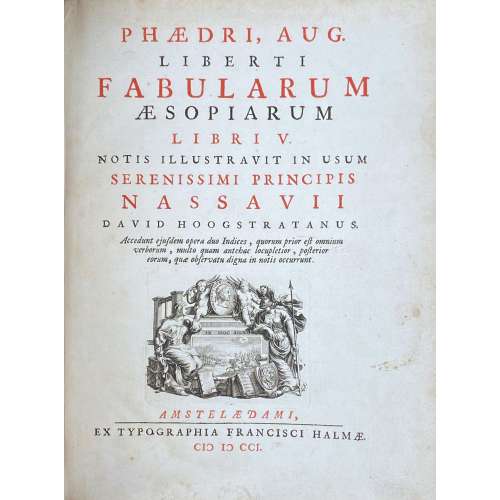 Phaedri, Aug. Liberti Fabularum Aesopiarum libri V / notis illustravit in usum serenissimi principis Nassavii David Hoogstratanus. Accedunt ejusdem opera duo indices, quorum prior est omnium verborum, multo quam antehac locupletior, posterior eorum, quae observatu digna in notis occurunt. — Amstelaedami : Ex Typographia Francisci Halmae, MDCCI [1701]. — pp.: [1] title, [1] (portr.), [32] 160, [84], 18 leaves of plates. Vita Phaedri is written by Johannes Schefferus (February 2, 1621 – March 26, 1679). Appendix fabularum is written by Marquard Gude (Gudius) (1 February 1635 – 26 November 1689). Gaius Julius Phaedrus was a 1st-century CE Roman fabulist and the first versifier of a collection of Aesop's fables into Latin. David van Hoogstraten (Rotterdam, March 14, 1658 - Amsterdam, November 21, 1724), a physician, poet and linguist, annotated the fables and dedicated them to Johan Willem Friso van Oranje-Nassau (14 August 1687 – 14 July 1711). The book was published in Amsterdam by François Halma (Langerak, January 3, 1653 - Leeuwarden, January 13, 1722), a Dutch printer, publisher and bookseller, with a portrait of Prince of Orange-Nassau, engraved by Pieter van Gunst (Dutch, Amsterdam 1659–1724) after Bernard Vaillant (Dutch, Lille 1632–1698 Leyden). The title page was engraved by P. Boutats after Jan Goeree (Dutch, Middelburg 1670–1731 Amsterdam). The edition is adorned throughout with 18 plates, each with 8 médaillons, designed and engraved by Jan van Vianen (Dutch, 1660–1726), and with vignettes, head- and tailpieces, inhabited initials, etc. Contemporary vellum over boards, title in red and back, red edges, 4to, 26 x 20 cm. Seller's description:4to, engraved general title, letterpress red & black title page with allegorical engraved vignette. 18 full-page copper-engraved plates by Jan van Vianen, each featuring six circular images, and 38 in-text reproductions, engraved decorative initials, and head- and tailpieces. Phaedrus (15 BC - 50 AD, Italy), was a "Roman fabulist, the first writer to Latinize whole books of fables, producing free versions in the iambic metre of Greek prose fables then circulating under the name of Aesop." (Ency. Brit.). This deluxe edition was specially created for the Prince of Nassau, profusely illustrated with fine engravings. Dibdin spoke highly of it in his Greek and Latin Classics (4th edition): "I have always considered this as a correct and very sumptuous edition. It is ornamented with a great number of small plates, or medallions, in which the subject of the fable is very ably and spiritedly executed.Ref.: Metropolitan Museum; Musée Médard
Phaedri, Aug. Liberti Fabularum Aesopiarum libri V / notis illustravit in usum serenissimi principis Nassavii David Hoogstratanus. Accedunt ejusdem opera duo indices, quorum prior est omnium verborum, multo quam antehac locupletior, posterior eorum, quae observatu digna in notis occurunt. — Amstelaedami : Ex Typographia Francisci Halmae, MDCCI [1701]. — pp.: [1] title, [1] (portr.), [32] 160, [84], 18 leaves of plates. Vita Phaedri is written by Johannes Schefferus (February 2, 1621 – March 26, 1679). Appendix fabularum is written by Marquard Gude (Gudius) (1 February 1635 – 26 November 1689). Gaius Julius Phaedrus was a 1st-century CE Roman fabulist and the first versifier of a collection of Aesop's fables into Latin. David van Hoogstraten (Rotterdam, March 14, 1658 - Amsterdam, November 21, 1724), a physician, poet and linguist, annotated the fables and dedicated them to Johan Willem Friso van Oranje-Nassau (14 August 1687 – 14 July 1711). The book was published in Amsterdam by François Halma (Langerak, January 3, 1653 - Leeuwarden, January 13, 1722), a Dutch printer, publisher and bookseller, with a portrait of Prince of Orange-Nassau, engraved by Pieter van Gunst (Dutch, Amsterdam 1659–1724) after Bernard Vaillant (Dutch, Lille 1632–1698 Leyden). The title page was engraved by P. Boutats after Jan Goeree (Dutch, Middelburg 1670–1731 Amsterdam). The edition is adorned throughout with 18 plates, each with 8 médaillons, designed and engraved by Jan van Vianen (Dutch, 1660–1726), and with vignettes, head- and tailpieces, inhabited initials, etc. Contemporary vellum over boards, title in red and back, red edges, 4to, 26 x 20 cm. Seller's description:4to, engraved general title, letterpress red & black title page with allegorical engraved vignette. 18 full-page copper-engraved plates by Jan van Vianen, each featuring six circular images, and 38 in-text reproductions, engraved decorative initials, and head- and tailpieces. Phaedrus (15 BC - 50 AD, Italy), was a "Roman fabulist, the first writer to Latinize whole books of fables, producing free versions in the iambic metre of Greek prose fables then circulating under the name of Aesop." (Ency. Brit.). This deluxe edition was specially created for the Prince of Nassau, profusely illustrated with fine engravings. Dibdin spoke highly of it in his Greek and Latin Classics (4th edition): "I have always considered this as a correct and very sumptuous edition. It is ornamented with a great number of small plates, or medallions, in which the subject of the fable is very ably and spiritedly executed.Ref.: Metropolitan Museum; Musée Médard -
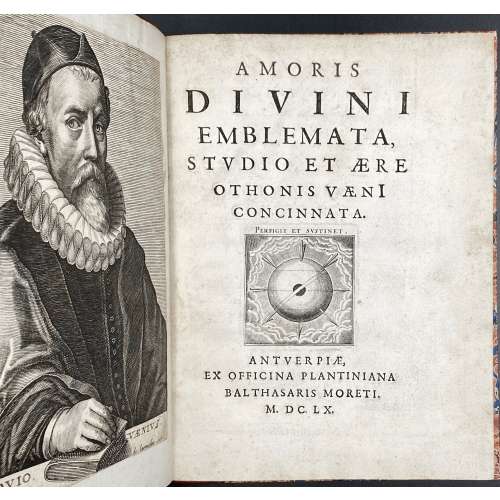 Amoris Divini Emblemata, Studio Et Aere Othonis Vaeni Concinata. — Antverpiae: Ex Officina Plantiniana Balthasaris Moreti, MDCLX [1660]. — pp.: [1] (Van Veen port.), [1] title, [2] (Isabella port.), 3-127 [1], 60 illustr. — 2nd impression. Octavius Vaenius, a.k.a. Otto Vaenius or Otto Van Veen (c. 1556-1629) was Rubens's last and most influential teacher. The Amoris divini emblemata was first published in 1615 by Nutius & Meursius in Antwerp. Vaenius’s book was to influence Herman Hugo's Pia desideria (LIB-1657.2018). Book structure: On frontispiece, trimmed and mounted portrait of Octavius Vaenius painted by his daughter Gertruida van Veen (signed Gertrudis filia) and engraved by Nicolas de Larmessin. Trimmed portrait of the Infanta Isabella Clara of Austria (1566 – 1633) pained by Peter Paul Rubens and engraved by Jan de Leeuw mounted to title verso. 60 engraved plates with emblems are on recto pages with facing texts: Latin quotations from Bible and Fathers, Spanish verses by Alphonso de Ledesma, Dutch by Vaenius and French by Carolus Philippus Hattron (d. 1632). Rebound in the mid-19th century in brown quarter Morocco with blind marbled boards and gilt lettering to spine. Inscription in ink on verso to van Veen portrait: "I bought this volume with the portraits inserted at the sale of the library of my uncle Samuel Rogers, Esq." Signed: "Frederick Sharpe, 1856". Frederick Sharpe (born was a son of Samuel Sharpe (1799–1881), the nephew of Samuel Rogers (1763–1855), a celebrated English poet. Size: 23.3 x 17.9 cm. Ref.: Emblem Project Utrecht (with an explanation of all the emblems); PETER BOOTHUYGENS: Similar or Dissimilar Loves?
Amoris Divini Emblemata, Studio Et Aere Othonis Vaeni Concinata. — Antverpiae: Ex Officina Plantiniana Balthasaris Moreti, MDCLX [1660]. — pp.: [1] (Van Veen port.), [1] title, [2] (Isabella port.), 3-127 [1], 60 illustr. — 2nd impression. Octavius Vaenius, a.k.a. Otto Vaenius or Otto Van Veen (c. 1556-1629) was Rubens's last and most influential teacher. The Amoris divini emblemata was first published in 1615 by Nutius & Meursius in Antwerp. Vaenius’s book was to influence Herman Hugo's Pia desideria (LIB-1657.2018). Book structure: On frontispiece, trimmed and mounted portrait of Octavius Vaenius painted by his daughter Gertruida van Veen (signed Gertrudis filia) and engraved by Nicolas de Larmessin. Trimmed portrait of the Infanta Isabella Clara of Austria (1566 – 1633) pained by Peter Paul Rubens and engraved by Jan de Leeuw mounted to title verso. 60 engraved plates with emblems are on recto pages with facing texts: Latin quotations from Bible and Fathers, Spanish verses by Alphonso de Ledesma, Dutch by Vaenius and French by Carolus Philippus Hattron (d. 1632). Rebound in the mid-19th century in brown quarter Morocco with blind marbled boards and gilt lettering to spine. Inscription in ink on verso to van Veen portrait: "I bought this volume with the portraits inserted at the sale of the library of my uncle Samuel Rogers, Esq." Signed: "Frederick Sharpe, 1856". Frederick Sharpe (born was a son of Samuel Sharpe (1799–1881), the nephew of Samuel Rogers (1763–1855), a celebrated English poet. Size: 23.3 x 17.9 cm. Ref.: Emblem Project Utrecht (with an explanation of all the emblems); PETER BOOTHUYGENS: Similar or Dissimilar Loves? -
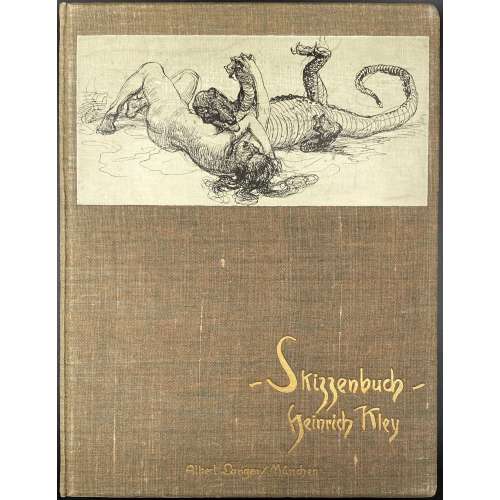
The edition consists of two albums:
1) Skizzenbuch: Hundert Federzeichnungen von Heinrich Kley. — München: Albert Langen, [1909]. — pp.: [1-4] 5-63 [64], illustr. Printed by Hesse & Becker in Leipzig. Bound in the original brown moire covered boards, with a paste-down drawing on the front, gilt cover titles, original patterned endpapers.
2) Skizzenbuch II. Hundert Federzeichnungen von Heinrich Kley. — München: Albert Langen, [1910]. — pp.: [1-4] 5-64, illustr. Printed by Hesse & Becker in Leipzig; paper by Bohnenberger & Cie.; binding by E. A. Enders, Leipzig. Bound in the original bluish-gray moire covered boards, with a paste-down drawing on the front, gilt cover titles, original patterned endpapers.
The number of printed copies unknown. Reproduction of ink drawings by Heinrich Kley, 1st edition.
Dimensions of each album: 32 x 24.5 cm; Quarto. Heinrich Kley (April 15, 1863 in Karlsruhe – 1945? in Munich) was a German illustrator, editorial illustrator and painter. -
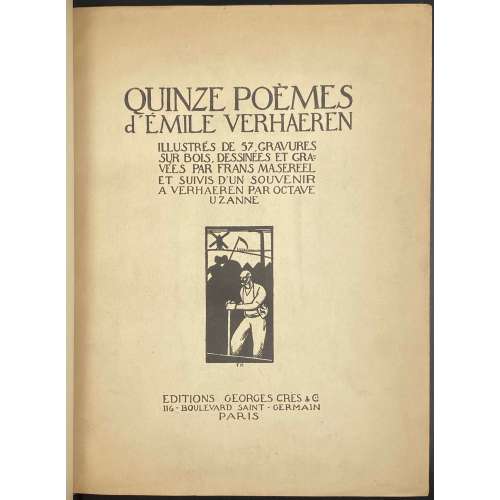 Quinze poèmes d'Emile Verhaeren. Illustrés de 57 gravures sur bois dessinées et gravées par Frans Masereel et suivis d'un 'Souvenir à Verhaeren' par Octave Uzanne. — Paris: Éditions Georges Crès, 1917. Authors: Emile Verhaeren (text), Frans Masereel (illustrations), Octave Uzanne (text). Publisher: Éditions Georges Crès. [Georges-Célestin Crès (1875 - 1935) was a French publisher and bookseller. Address: 116 boulevard Saint-Germain, Paris]. Printer: Sonor S.A. - Geneve, under the direction of Auguste Jordanis. The number of copies printed: 1555 of which 15 (1-15) on Japan paper, 190 (16-205) on Fabriano paper, and 1350 (206-1555) on English paper (1506-1555 not for trade). This copy № 1312. Pagination: [i] - front cover, [ii] - half-title, [iii] - title, [iv] - printrun justification, [v] - table of contents, [vi] - blank, [i-vii] viii-ciii, [civ] - printer statement, [cv] - back cover; one-side (recto) printing and pagination. Owner's contemporary red half-Morocco with marbled boards; spine with four raised bands, gilt lettering and design elements. Original printed paper wrappers preserved. Marbled endpapers. Trimmed unevenly.
Quinze poèmes d'Emile Verhaeren. Illustrés de 57 gravures sur bois dessinées et gravées par Frans Masereel et suivis d'un 'Souvenir à Verhaeren' par Octave Uzanne. — Paris: Éditions Georges Crès, 1917. Authors: Emile Verhaeren (text), Frans Masereel (illustrations), Octave Uzanne (text). Publisher: Éditions Georges Crès. [Georges-Célestin Crès (1875 - 1935) was a French publisher and bookseller. Address: 116 boulevard Saint-Germain, Paris]. Printer: Sonor S.A. - Geneve, under the direction of Auguste Jordanis. The number of copies printed: 1555 of which 15 (1-15) on Japan paper, 190 (16-205) on Fabriano paper, and 1350 (206-1555) on English paper (1506-1555 not for trade). This copy № 1312. Pagination: [i] - front cover, [ii] - half-title, [iii] - title, [iv] - printrun justification, [v] - table of contents, [vi] - blank, [i-vii] viii-ciii, [civ] - printer statement, [cv] - back cover; one-side (recto) printing and pagination. Owner's contemporary red half-Morocco with marbled boards; spine with four raised bands, gilt lettering and design elements. Original printed paper wrappers preserved. Marbled endpapers. Trimmed unevenly. -
 A two-volume set: (1) Thomas Hugo. The Bewick Collector. A Descriptive Catalogue of the Works of Thomas and John Bewick; Including cuts, in various states, for Books and Pamphlets, Private Gentlemen, Public Companies, Exhibitions, Races, Newspapers, Shop Cards, Invoice Heads, Bar Bills, Coal Certificates, Broadsides, and other miscellaneous purposes, and Wood Blocks. With an Appendix of Portraits, Autographs, Works of Pupils, etc., etc. The whole described from the Originals contained in the largest and most perfect collection ever formed, and illustrated with a hundred and twelve cuts. — London: Lovell Reeve and Co., MDCCCLXVI [1866]. — [Printed by] J. E. Taylor and Co., printers. — pp.: [i-v] vi-xxiii [xxiv], [1] 2-562. (2) Thomas Hugo. The Bewick Collector. A Supplement to a Descriptive Catalogue of the Works of Thomas and John Bewick; Consisting of additions to the various divisions of cuts, wood blocks. etc., enumerated in that work. The whole described from the Originals contained in the largest and most perfect collection ever formed, and illustrated with a hundred and eighty cuts. — London: L. Reeve and Co, MDCCCLXVIII [1868]. — [Printed by] J. E. Taylor and Co., printers. — pp.: [i-vii] viii-xxxii, [1] 2-353. Both volumes in 8vo, 22.5 x 14.5 cm, hardcover. Contemporary dark brown half morocco, gilt-ruled, with 5 raised bands, gilt titles and decoration to spine, and marbled paper over boards. Top edge gilt; marbled endpapers. Binding splitting at pp.80/81 of the 1st volume. Armorial bookplate of Ralph Hart Tweddle to front pastedown. Ralph Hart Tweddle (1843 – 1895) was a British mechanical engineer, known particularly for inventing the portable hydraulic riveter, which greatly facilitated the construction of boilers, bridges and ships.
A two-volume set: (1) Thomas Hugo. The Bewick Collector. A Descriptive Catalogue of the Works of Thomas and John Bewick; Including cuts, in various states, for Books and Pamphlets, Private Gentlemen, Public Companies, Exhibitions, Races, Newspapers, Shop Cards, Invoice Heads, Bar Bills, Coal Certificates, Broadsides, and other miscellaneous purposes, and Wood Blocks. With an Appendix of Portraits, Autographs, Works of Pupils, etc., etc. The whole described from the Originals contained in the largest and most perfect collection ever formed, and illustrated with a hundred and twelve cuts. — London: Lovell Reeve and Co., MDCCCLXVI [1866]. — [Printed by] J. E. Taylor and Co., printers. — pp.: [i-v] vi-xxiii [xxiv], [1] 2-562. (2) Thomas Hugo. The Bewick Collector. A Supplement to a Descriptive Catalogue of the Works of Thomas and John Bewick; Consisting of additions to the various divisions of cuts, wood blocks. etc., enumerated in that work. The whole described from the Originals contained in the largest and most perfect collection ever formed, and illustrated with a hundred and eighty cuts. — London: L. Reeve and Co, MDCCCLXVIII [1868]. — [Printed by] J. E. Taylor and Co., printers. — pp.: [i-vii] viii-xxxii, [1] 2-353. Both volumes in 8vo, 22.5 x 14.5 cm, hardcover. Contemporary dark brown half morocco, gilt-ruled, with 5 raised bands, gilt titles and decoration to spine, and marbled paper over boards. Top edge gilt; marbled endpapers. Binding splitting at pp.80/81 of the 1st volume. Armorial bookplate of Ralph Hart Tweddle to front pastedown. Ralph Hart Tweddle (1843 – 1895) was a British mechanical engineer, known particularly for inventing the portable hydraulic riveter, which greatly facilitated the construction of boilers, bridges and ships. -
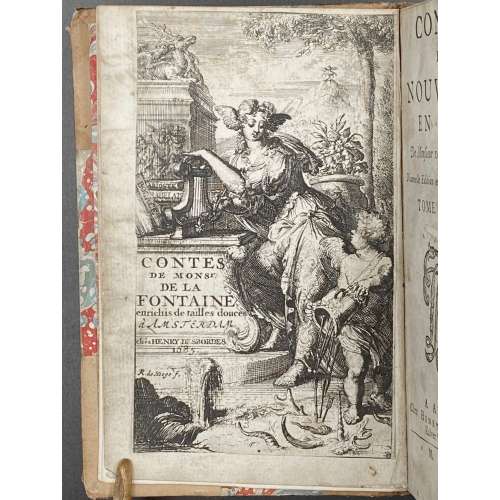 [Jean de LA FONTAINE]. Contes et nouvelles en vers. De Monsieur de La Fontaine. Nouvelle édition enrichie de tailles-douces. À Amsterdam | Chez Henry Desbordes, MDCLXXXV [1685]. — 2 vol. in 1. Pagination: [1] - frontispiece with pasted illustr., [*1] - title p. with blank verso, *2-*5 (only recto numbered) - advertisement, [1] - preface vol. 1, [2] table, 1-236; [6] - preface vol. 2, 1-216, illustr. (in text). Etched frontispiece plate and 58 half-page etchings at the head of each chapter as well as endpiece vignettes, all by R. de Hooge (Romeyn de Hooghe, 1645 – 1708, a Dutch painter, sculptor, engraver and caricaturist. First illustrated edition. "Publication of the scandalous fables was forbidden in France from 1674. According to Van Eeghen, this edition was published without the knowledge of La Fontaine. ...This is the edition with ‘Le Juge de Nêle’ (instead of Mesle) in the contents of the first volume, as well as page 211 for 'Dissertation sur la Joconde'; 16 lines of text on page 211; and 19 lines of text on the first page of the preface of volume 2" [1]. Pott 8vo (15.4 x 10 cm), hardcover; owner's later tan polished half-calf, marbled boards, marbled pastedowns and flyleaves, 5 raised bands, dark brown labels with gilt lettering and gilt roll patterns on spine, tail of the spine slightly damaged. Corners bumped, spotted stains on leather. Henri Desbordes (d. ca. 1722) was a Huguenot printer who was exiled from his business in France and set up as a publisher in Amsterdam in the 17th century.
[Jean de LA FONTAINE]. Contes et nouvelles en vers. De Monsieur de La Fontaine. Nouvelle édition enrichie de tailles-douces. À Amsterdam | Chez Henry Desbordes, MDCLXXXV [1685]. — 2 vol. in 1. Pagination: [1] - frontispiece with pasted illustr., [*1] - title p. with blank verso, *2-*5 (only recto numbered) - advertisement, [1] - preface vol. 1, [2] table, 1-236; [6] - preface vol. 2, 1-216, illustr. (in text). Etched frontispiece plate and 58 half-page etchings at the head of each chapter as well as endpiece vignettes, all by R. de Hooge (Romeyn de Hooghe, 1645 – 1708, a Dutch painter, sculptor, engraver and caricaturist. First illustrated edition. "Publication of the scandalous fables was forbidden in France from 1674. According to Van Eeghen, this edition was published without the knowledge of La Fontaine. ...This is the edition with ‘Le Juge de Nêle’ (instead of Mesle) in the contents of the first volume, as well as page 211 for 'Dissertation sur la Joconde'; 16 lines of text on page 211; and 19 lines of text on the first page of the preface of volume 2" [1]. Pott 8vo (15.4 x 10 cm), hardcover; owner's later tan polished half-calf, marbled boards, marbled pastedowns and flyleaves, 5 raised bands, dark brown labels with gilt lettering and gilt roll patterns on spine, tail of the spine slightly damaged. Corners bumped, spotted stains on leather. Henri Desbordes (d. ca. 1722) was a Huguenot printer who was exiled from his business in France and set up as a publisher in Amsterdam in the 17th century. -
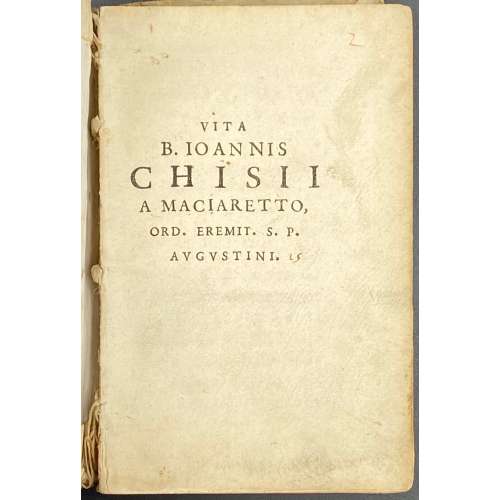 [Michael Hoyer]. Vita B. Ioannis Chisii a Maciaretto, ord. ermit. s. p. Augustini. — Antverpiæ, Apud Henricum Aertssens, Anno MDCXLI [1641]. Pagination: [2] *3+recto unpag. *4+recto unpag., [10], 5-135 [3]. Illustrations: Frontispiece missing, 4 copperplate engravings (pp. 22, 64, 90, and 120) by Pieter de Jode the Younger (1606–1674, Flemish printmaker, draughtsman, painter and art dealer) after Erasmus Quellinus the Younger (1607–1678, Flemish painter, engraver, draughtsman and tapestry designer). Size: Pott 8vo (15.5 x 10 cm), vellum binding. Expanded title: Vita Beati Ioannis Chisii, a Maciaretto, Ordinis Eremitarum Sancti Patris Augustini. [Translation: Life of Blessed Giovanni Chigi from Maciaretto, Order of Hermits of St. Augustine]. Blessed Giovanni Chigi (1300 - 1363) [1] was a lay brother of the Order of Hermits of St. Augustine. The Chigi family is a Roman princely family of Sienese extraction descended from the counts of Ardenghesca. The earliest authentic mention of them is in the 13th century, with one Alemanno, counsellor of the Republic of Siena. The Wikipedia article does not mention Giovanni Chigi, however, it states that one of the Chigi, Cardinal Fabio Chigi, was elected pope as Alexander VII at the Conclave of 1655. The book was published in 1641 with a dedication to the said Cardinal Fabio Chigi before he was elected pope. The town, Maciaretto, where Giovanni Chigi was from, is unclear because there is no such place in modern Italy, and there are two places called Macereto: (1) Macereto Alta/Basso in Perugia province and (2) Macereto in the municipality of Visso, in the province of Macerata, region Marche. I assume that our Giovanni Chigi was from the one that is closer to Siena, i.e. Macereto in Perugia province. Regarding the author. There is no author's name in the book. However, in various sources, the book is mentioned as written by Michel Hoyer, who was born in Hesdin, Flanders in 1593 and died in 1650. He pursued an ecclesiastical career and professed rhetoric at the College of Saint Pierre in Lille. He later joined the Order of Saint Augustine, in the convent of Ypres, and settled in various schools in the Netherlands. His reputation attracted many students, among them Albert Rubens (1614–1657), the eldest son of Peter Paul Rubens and Isabella Brant. Michel Hoyer wrote several books, the most known is Flammulae amoris, S.P. Augustini versibus et iconibus exornatae:
[Michael Hoyer]. Vita B. Ioannis Chisii a Maciaretto, ord. ermit. s. p. Augustini. — Antverpiæ, Apud Henricum Aertssens, Anno MDCXLI [1641]. Pagination: [2] *3+recto unpag. *4+recto unpag., [10], 5-135 [3]. Illustrations: Frontispiece missing, 4 copperplate engravings (pp. 22, 64, 90, and 120) by Pieter de Jode the Younger (1606–1674, Flemish printmaker, draughtsman, painter and art dealer) after Erasmus Quellinus the Younger (1607–1678, Flemish painter, engraver, draughtsman and tapestry designer). Size: Pott 8vo (15.5 x 10 cm), vellum binding. Expanded title: Vita Beati Ioannis Chisii, a Maciaretto, Ordinis Eremitarum Sancti Patris Augustini. [Translation: Life of Blessed Giovanni Chigi from Maciaretto, Order of Hermits of St. Augustine]. Blessed Giovanni Chigi (1300 - 1363) [1] was a lay brother of the Order of Hermits of St. Augustine. The Chigi family is a Roman princely family of Sienese extraction descended from the counts of Ardenghesca. The earliest authentic mention of them is in the 13th century, with one Alemanno, counsellor of the Republic of Siena. The Wikipedia article does not mention Giovanni Chigi, however, it states that one of the Chigi, Cardinal Fabio Chigi, was elected pope as Alexander VII at the Conclave of 1655. The book was published in 1641 with a dedication to the said Cardinal Fabio Chigi before he was elected pope. The town, Maciaretto, where Giovanni Chigi was from, is unclear because there is no such place in modern Italy, and there are two places called Macereto: (1) Macereto Alta/Basso in Perugia province and (2) Macereto in the municipality of Visso, in the province of Macerata, region Marche. I assume that our Giovanni Chigi was from the one that is closer to Siena, i.e. Macereto in Perugia province. Regarding the author. There is no author's name in the book. However, in various sources, the book is mentioned as written by Michel Hoyer, who was born in Hesdin, Flanders in 1593 and died in 1650. He pursued an ecclesiastical career and professed rhetoric at the College of Saint Pierre in Lille. He later joined the Order of Saint Augustine, in the convent of Ypres, and settled in various schools in the Netherlands. His reputation attracted many students, among them Albert Rubens (1614–1657), the eldest son of Peter Paul Rubens and Isabella Brant. Michel Hoyer wrote several books, the most known is Flammulae amoris, S.P. Augustini versibus et iconibus exornatae: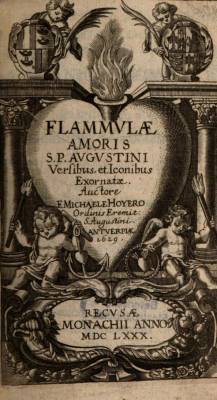 Surprisingly, there is only limited information about Michel Hoyer in Spanish Wikipedia; other language versions of his biography do not exist. Another author mentioned in the book is some anonymous Augustinian from Cologne.
Regarding the illustrations. In our copy, the frontispiece is missing. It was probably ripped off by some unscrupulous seller of antique prints.
The image on the missing frontispiece is this:
Surprisingly, there is only limited information about Michel Hoyer in Spanish Wikipedia; other language versions of his biography do not exist. Another author mentioned in the book is some anonymous Augustinian from Cologne.
Regarding the illustrations. In our copy, the frontispiece is missing. It was probably ripped off by some unscrupulous seller of antique prints.
The image on the missing frontispiece is this:
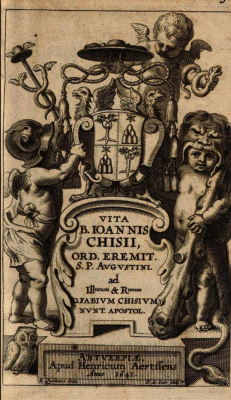 The names of the artists engraved in the bottom of the stone: E. Quellinus, delin. to the left and P. de Jode, fecit. to the right. We can infer that the other illustrations in that book are produced by the same duo. The image represents three cherubs: one with Athena's serpent in his left hand and a cardinal's hat in his right hand; another in Athen's helmet on his head and her owl beside his feet, with the staff of Mercurius (serpent-twined staff adorned with a winged hat) in his left hand, and the House of Chigi - Della Rovere coat of arms in his right hand; the third cherub depicted with the Hercules attributes - lion pelt and a club.
Regarding the publisher. Henricum Aertssens or Hendrik Aertssen, 1586-1658. Besides the other books, he published PIA DESIDERIA by Herman Hugo in 1636 [1621 french edition by Jean Cnobbartin in Antwerp in his collection LIB-1657.2018]. According to Nina Lamal [2], nothing is known about career of this publisher, besides what's said in Adresboek van zeventiende-eeuwse drukkers, uitgevers en boekverkopers in Vlaanderen / Directory of seventeenth-century Printers, Publishers and Booksellers in Flanders / Vlieger-De Wilde, Koen De (editor). The list of his publications can be seen here.
Other artists who turned to the figure of Blessed Giovanni Chigi were Abraham van Diepenbeeck (painter) and Conrad Lauwers (engraver). The print is in Rijksmuseum, in Amsterdam.
The names of the artists engraved in the bottom of the stone: E. Quellinus, delin. to the left and P. de Jode, fecit. to the right. We can infer that the other illustrations in that book are produced by the same duo. The image represents three cherubs: one with Athena's serpent in his left hand and a cardinal's hat in his right hand; another in Athen's helmet on his head and her owl beside his feet, with the staff of Mercurius (serpent-twined staff adorned with a winged hat) in his left hand, and the House of Chigi - Della Rovere coat of arms in his right hand; the third cherub depicted with the Hercules attributes - lion pelt and a club.
Regarding the publisher. Henricum Aertssens or Hendrik Aertssen, 1586-1658. Besides the other books, he published PIA DESIDERIA by Herman Hugo in 1636 [1621 french edition by Jean Cnobbartin in Antwerp in his collection LIB-1657.2018]. According to Nina Lamal [2], nothing is known about career of this publisher, besides what's said in Adresboek van zeventiende-eeuwse drukkers, uitgevers en boekverkopers in Vlaanderen / Directory of seventeenth-century Printers, Publishers and Booksellers in Flanders / Vlieger-De Wilde, Koen De (editor). The list of his publications can be seen here.
Other artists who turned to the figure of Blessed Giovanni Chigi were Abraham van Diepenbeeck (painter) and Conrad Lauwers (engraver). The print is in Rijksmuseum, in Amsterdam.
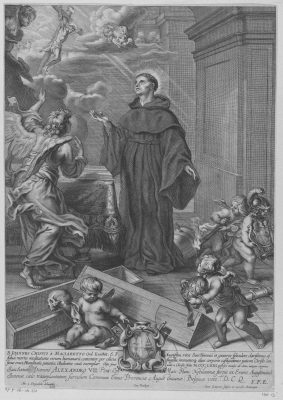 Here we see a more complex composition but with a clear reference to the work of Quellinus and de Jode: The cherub in Athena's helmet takes away the old coat of arms of the Chigi, and the other cherub points out to the new one, with papal symbols of St. Peter's keys, another cherub carries the papal tiara. Rijksmuseum dates the image as 1642 - 1685; most probably it is ca. 1655, when Fabio Chigi became Pope Alexander VII, and propaganda was focused on promoting his outstanding ancestor Giovanni, who died 300 years before. Giovanni Chigi is depicted here resurrected, accompanied by the archangel, and receiving the blessing from Jesus on the cross.
1 - Michael J. Walsh. A New Dictionary of Saints: East and West, p. 308.
2 - Nina Lamal. Publishing military books in the Low Countries and in Italy in the early seventeenth century in 'Specialist Markets in the Early Modern Book World', ed. Richard Kirwan, Sophia Mullins, Leiden: Koninklijke Brill, 2015, pp. 232-233.
Here we see a more complex composition but with a clear reference to the work of Quellinus and de Jode: The cherub in Athena's helmet takes away the old coat of arms of the Chigi, and the other cherub points out to the new one, with papal symbols of St. Peter's keys, another cherub carries the papal tiara. Rijksmuseum dates the image as 1642 - 1685; most probably it is ca. 1655, when Fabio Chigi became Pope Alexander VII, and propaganda was focused on promoting his outstanding ancestor Giovanni, who died 300 years before. Giovanni Chigi is depicted here resurrected, accompanied by the archangel, and receiving the blessing from Jesus on the cross.
1 - Michael J. Walsh. A New Dictionary of Saints: East and West, p. 308.
2 - Nina Lamal. Publishing military books in the Low Countries and in Italy in the early seventeenth century in 'Specialist Markets in the Early Modern Book World', ed. Richard Kirwan, Sophia Mullins, Leiden: Koninklijke Brill, 2015, pp. 232-233.
-
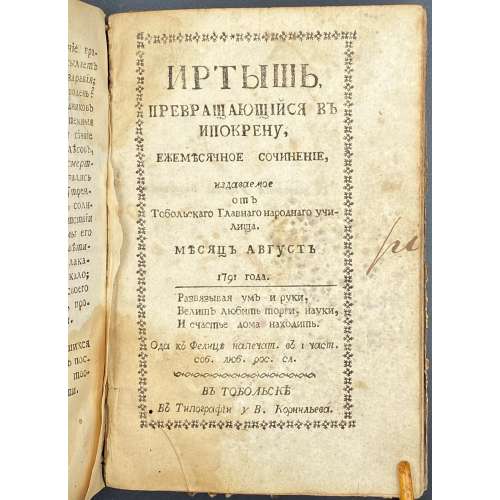 Конволют из 3-х номеров журнала "Иртыш, превращающийся в Ипокрену". Ежемесячное сочинение издаваемое от Тобольского Главного Народного Училища. — В типографии у В. Корнильева. — Тобольск: Тобольское главное народное училище, 1791 г. — 60, 62, 54 с. (Дореформ. орф.). July (Июль) 1791. — pp.: Missing title, table of content unpag., verso blank, [1] 2-60. June (Июнь) 1791. — pp.: Title with censor stat. on verso, table of content unpag., verso blank, [1] 2-62. August (Август) 1791. — pp.: Title, table of content unpag., verso blank, [1] 2-54. Bound in this order. "The Irtysh river turning into Hippocrene" was the first monthly magazine in Russian Siberia published in 1789 — 1791 in Tobolsk. It was featuring journalism, commentary, poetry, the fiction of provincial and metropolitan authors, as well as translations of various articles from foreign journals. It was published by Department of Tobolsk Public Education and printed in the establishment of Kornil'ev (Корнильев), a local merchant. The idea of publication belonged to Pankraty Sumarokov (1765 — 1814), a grandnephew of Alexander Sumarokov, distinguished Russian humanist and homme de lettres of Catherine the Great epoch. Pankraty was also the chief editor of the publication. Initially, the print run was 300 copies; reduced in 1791 to 106 copies only.
Конволют из 3-х номеров журнала "Иртыш, превращающийся в Ипокрену". Ежемесячное сочинение издаваемое от Тобольского Главного Народного Училища. — В типографии у В. Корнильева. — Тобольск: Тобольское главное народное училище, 1791 г. — 60, 62, 54 с. (Дореформ. орф.). July (Июль) 1791. — pp.: Missing title, table of content unpag., verso blank, [1] 2-60. June (Июнь) 1791. — pp.: Title with censor stat. on verso, table of content unpag., verso blank, [1] 2-62. August (Август) 1791. — pp.: Title, table of content unpag., verso blank, [1] 2-54. Bound in this order. "The Irtysh river turning into Hippocrene" was the first monthly magazine in Russian Siberia published in 1789 — 1791 in Tobolsk. It was featuring journalism, commentary, poetry, the fiction of provincial and metropolitan authors, as well as translations of various articles from foreign journals. It was published by Department of Tobolsk Public Education and printed in the establishment of Kornil'ev (Корнильев), a local merchant. The idea of publication belonged to Pankraty Sumarokov (1765 — 1814), a grandnephew of Alexander Sumarokov, distinguished Russian humanist and homme de lettres of Catherine the Great epoch. Pankraty was also the chief editor of the publication. Initially, the print run was 300 copies; reduced in 1791 to 106 copies only. -
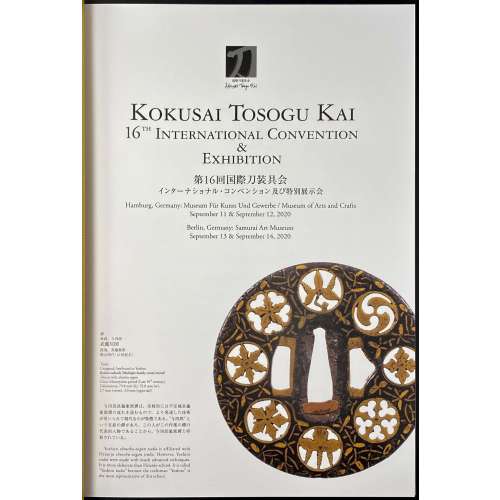 An annual publication of Kokusai Tosogu Kai / 16th International Convention & Exhibition in Hamburg, Germany: Museum Für Kunst Und Gewerbe / Museum of Arts and Crafts, September 11-12, 2020 and Berlin, Germany: Samurai Art Museum, September 13-14, 2020. Publisher: Tokyo: Kokusai Tosogu Kai, 2020. Pagination: [1-3] 4-103 [1]. Size: Medium 4to (30.3 x 21.6 cm), hardcover, original illustrated paper boards, in a slipcase. Tsuba from this collection depicted on the title page and pp. 59-60: TSU-0342.2017, TSU 0376.2018, and TSU 0379.2018. See also here.
An annual publication of Kokusai Tosogu Kai / 16th International Convention & Exhibition in Hamburg, Germany: Museum Für Kunst Und Gewerbe / Museum of Arts and Crafts, September 11-12, 2020 and Berlin, Germany: Samurai Art Museum, September 13-14, 2020. Publisher: Tokyo: Kokusai Tosogu Kai, 2020. Pagination: [1-3] 4-103 [1]. Size: Medium 4to (30.3 x 21.6 cm), hardcover, original illustrated paper boards, in a slipcase. Tsuba from this collection depicted on the title page and pp. 59-60: TSU-0342.2017, TSU 0376.2018, and TSU 0379.2018. See also here. -
 Utagawa Kunisada (Japanese: 歌川 国貞; also known as Utagawa Toyokuni III (三代歌川豊国); 1786 – 12 January 1865).
Utagawa Kunisada (Japanese: 歌川 国貞; also known as Utagawa Toyokuni III (三代歌川豊国); 1786 – 12 January 1865).A young woman reading a book in the light of a lamp. Series: Arigataki miyo no kage-e (Shadow Pictures of an Auspicious Age). There are five known prints, half-length portraits of beauties, in this series, designed by Kunisada in ca. 1844. Another print from the series in this collection: SVJP-0306.2020: A young woman adjusting her hairpins in the light of a paper lantern.
Signed: Kōchōrō Toyokuni ga (香蝶楼豊国画).
Publisher: Maruya Kiyojiro.
Size: Vertical Ōban (37.5 x 25.4 cm). -
 Utagawa Kunisada (Japanese: 歌川 国貞; also known as Utagawa Toyokuni III (三代歌川豊国); 1786 – 12 January 1865).
Utagawa Kunisada (Japanese: 歌川 国貞; also known as Utagawa Toyokuni III (三代歌川豊国); 1786 – 12 January 1865).A young woman adjusting her hairpins in the light of a paper lantern. Series: Arigataki miyo no kage-e (Shadow Pictures of an Auspicious Age). There are five known prints, half-length portraits of beauties, in this series, designed by Kunisada in ca. 1844. Another print from the series in this collection: SVJP-0309.2020: A young woman reading a book in the light of a lamp.
Signed: Kōchōrō Toyokuni ga (香蝶楼豊国画). Publisher: Maruya Kiyojiro.
Size: Vertical Ōban (37.5 x 25.4 cm). Utagawa (歌川) SOLD -
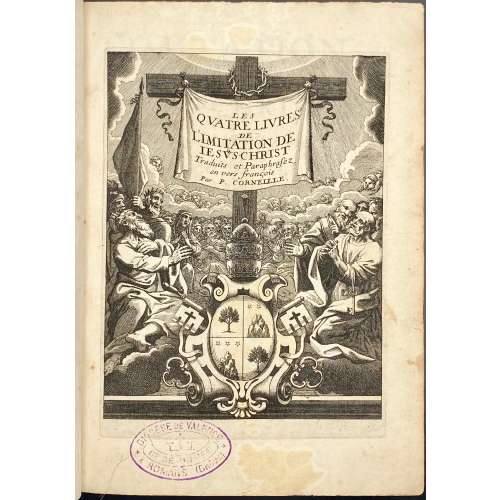 L'Imitation de Jésus-Christ / Traduite et paraphrasée en Vers François Par P. Corneille. — A Paris, Chez Pierre Rocolet, Imprimeur & Libraire ordinaire du Roy, au Palais, en la Gallerie des Prisonniers, aux Armes du Roy & de la Ville. M. DC. LVI. Avec Approbation des Docteurs, et Privelege de sa Majesté. Paris: Pierre Rocolet, 1656. Half-title: Les Quatre Livres de L'Imitation de Iesus-Christ. Traduites et paraphrasez en vers françois Par P. Corneille. — pp.: ff [2 pictorial ht, verso blank] [2 title, blank] [10 epistre] [2 av lecteur] [2 approbation, frontis.] 1-551 [552-60 table, privilege] bf. 8vo, 24.7 x 18.7 cm, hardcover; full speckled brown calf, gilt double-ruled boards, spine with raised bands, gilt double-ruled compartments with lozenges, sprayed margins; pages darkened. Purple ink stamp of Diocèse de Valencia to half-title. Nut ink ex libris handwriting on front paste-down. Plates: Half-title: unsigned copper engraving with the coat of arms of Pope Alexander VII (r. 1655 – 1667) which contains an oak tree in the top left and bottom right quarters (from Della Rovere family, Dukes of Urbino), the top right and bottom left quarters feature a mountain of six coupeaux in base with three stars above (from Chigi family). Four copper engravings inbound at the beginning of each book signed 'F. Chauueau in et fe.': Page 1: Jesus teaches His disciple. Page 113: Annunciation. Page 183: Jesus meets Simon called Peter and his brother Andrew. Page 459: Last Supper. François Chauveau (10 May 1613, Paris – 3 February 1676, Paris), a French painter and engraver. Thomas à Kempis (c. 1380 – 25 July 1471), a German-Dutch canon regular. Pierre Corneille (1606 – 1684), a French poet and playwright. Pierre Rocolet (1610 – 1662, active circa 1638 à 1662), a French publisher and printer.
L'Imitation de Jésus-Christ / Traduite et paraphrasée en Vers François Par P. Corneille. — A Paris, Chez Pierre Rocolet, Imprimeur & Libraire ordinaire du Roy, au Palais, en la Gallerie des Prisonniers, aux Armes du Roy & de la Ville. M. DC. LVI. Avec Approbation des Docteurs, et Privelege de sa Majesté. Paris: Pierre Rocolet, 1656. Half-title: Les Quatre Livres de L'Imitation de Iesus-Christ. Traduites et paraphrasez en vers françois Par P. Corneille. — pp.: ff [2 pictorial ht, verso blank] [2 title, blank] [10 epistre] [2 av lecteur] [2 approbation, frontis.] 1-551 [552-60 table, privilege] bf. 8vo, 24.7 x 18.7 cm, hardcover; full speckled brown calf, gilt double-ruled boards, spine with raised bands, gilt double-ruled compartments with lozenges, sprayed margins; pages darkened. Purple ink stamp of Diocèse de Valencia to half-title. Nut ink ex libris handwriting on front paste-down. Plates: Half-title: unsigned copper engraving with the coat of arms of Pope Alexander VII (r. 1655 – 1667) which contains an oak tree in the top left and bottom right quarters (from Della Rovere family, Dukes of Urbino), the top right and bottom left quarters feature a mountain of six coupeaux in base with three stars above (from Chigi family). Four copper engravings inbound at the beginning of each book signed 'F. Chauueau in et fe.': Page 1: Jesus teaches His disciple. Page 113: Annunciation. Page 183: Jesus meets Simon called Peter and his brother Andrew. Page 459: Last Supper. François Chauveau (10 May 1613, Paris – 3 February 1676, Paris), a French painter and engraver. Thomas à Kempis (c. 1380 – 25 July 1471), a German-Dutch canon regular. Pierre Corneille (1606 – 1684), a French poet and playwright. Pierre Rocolet (1610 – 1662, active circa 1638 à 1662), a French publisher and printer. -
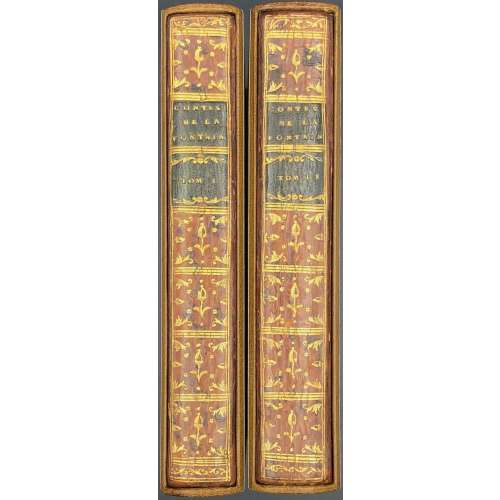 Two-volume edition, financed, arranged and managed by Fermiers généraux. Vol. 1. Title : CONTES | ET | NOUVELLES | EN VERS, | Par M. de La Fontaine. | TOME I. | {vignette} | A AMSTERDAM. | — | M. DCC. LXII. || Pagination: [2] – blanks [i, ii] – h.t. / blank, [iii, iv] – t.p. / blank, v-xiv, [1] 2–268 [269-70] – table, [4] – blanks, plus frontispiece by Fiquet after Rigault, t.p. vignette, vignette, headpiece, and 23 tailpieces by Choffard, 39 plates by various engravers after Charles Eisen. Vol. 2. Title: same but TOME II. Pagination: [2] – blanks] [i, ii] – h.t. / blank, [iii] iv-viii [1] 2–306 [307-10] – épitaphe / table, [4] – blanks, plus frontispiece by Fiquet after Vispré, t.p. vignette, vignette, headpiece, and 29 tailpieces by Choffard, and 42 plates after Charles Eisen (Ray only cite 41 plates). Binding: 2 volumes, 19.8 x 12.2 each, uniformly bound in full Spanish mottled calf, boards triple ruled in gilt, flat spine with triple bands, double ruled and tooled in gilt, black title labels lettered in gilt, all margins gilt, marbled end-papers, in cardboard slipcases, openings leathered. In vol. 1 a manuscript plate 4.8 x 8.2 cm pasted to page [1]: "Cette Édition est très rare n’y ayant | eu que 30 Exemplaires de livres, ou la figure principale dans le Cas de Conscience page 143 Tom 2 est nud tandis que dans les autres Éditions cette Figure est voilée par un feuillage".
Two-volume edition, financed, arranged and managed by Fermiers généraux. Vol. 1. Title : CONTES | ET | NOUVELLES | EN VERS, | Par M. de La Fontaine. | TOME I. | {vignette} | A AMSTERDAM. | — | M. DCC. LXII. || Pagination: [2] – blanks [i, ii] – h.t. / blank, [iii, iv] – t.p. / blank, v-xiv, [1] 2–268 [269-70] – table, [4] – blanks, plus frontispiece by Fiquet after Rigault, t.p. vignette, vignette, headpiece, and 23 tailpieces by Choffard, 39 plates by various engravers after Charles Eisen. Vol. 2. Title: same but TOME II. Pagination: [2] – blanks] [i, ii] – h.t. / blank, [iii] iv-viii [1] 2–306 [307-10] – épitaphe / table, [4] – blanks, plus frontispiece by Fiquet after Vispré, t.p. vignette, vignette, headpiece, and 29 tailpieces by Choffard, and 42 plates after Charles Eisen (Ray only cite 41 plates). Binding: 2 volumes, 19.8 x 12.2 each, uniformly bound in full Spanish mottled calf, boards triple ruled in gilt, flat spine with triple bands, double ruled and tooled in gilt, black title labels lettered in gilt, all margins gilt, marbled end-papers, in cardboard slipcases, openings leathered. In vol. 1 a manuscript plate 4.8 x 8.2 cm pasted to page [1]: "Cette Édition est très rare n’y ayant | eu que 30 Exemplaires de livres, ou la figure principale dans le Cas de Conscience page 143 Tom 2 est nud tandis que dans les autres Éditions cette Figure est voilée par un feuillage".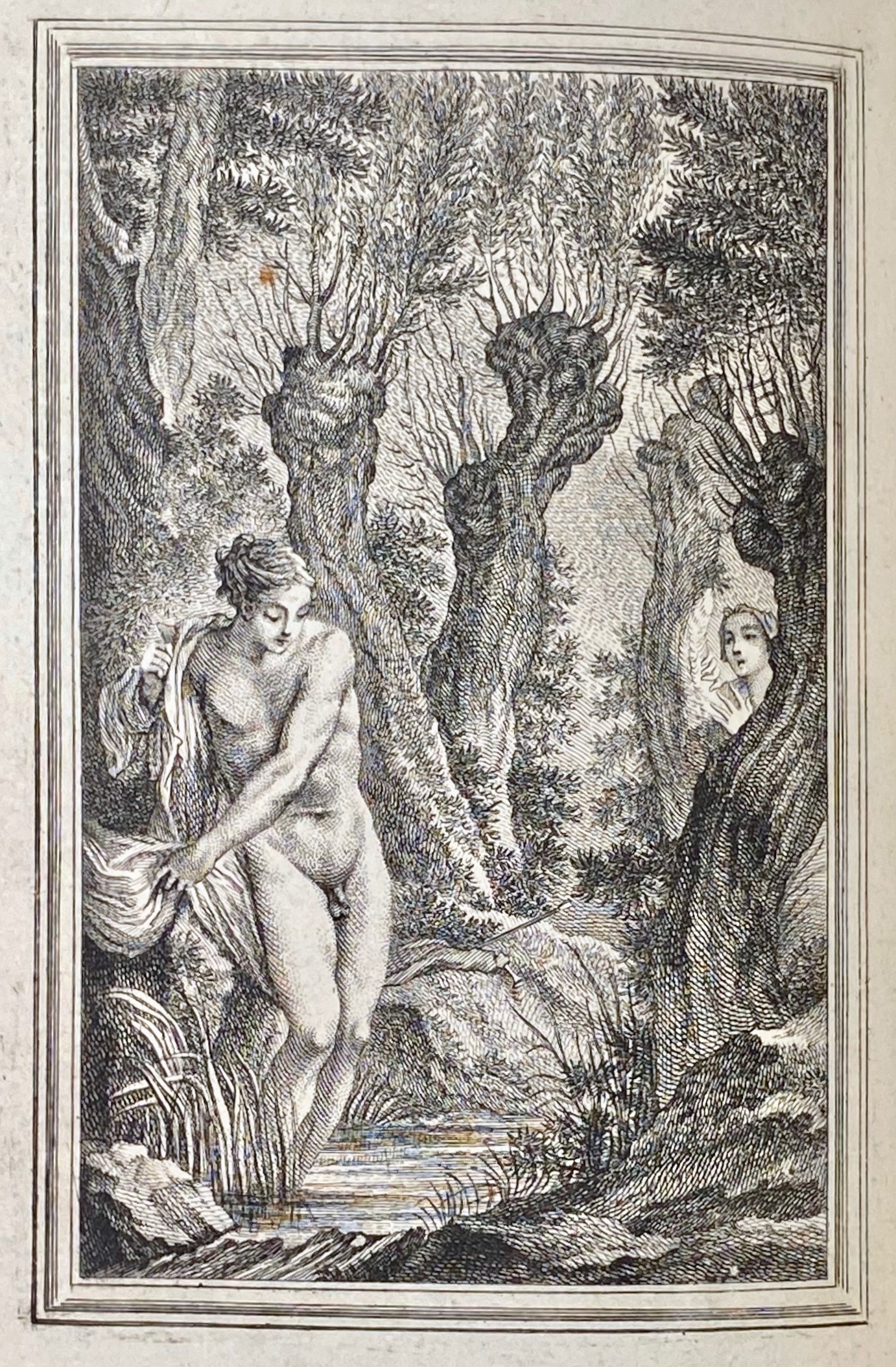
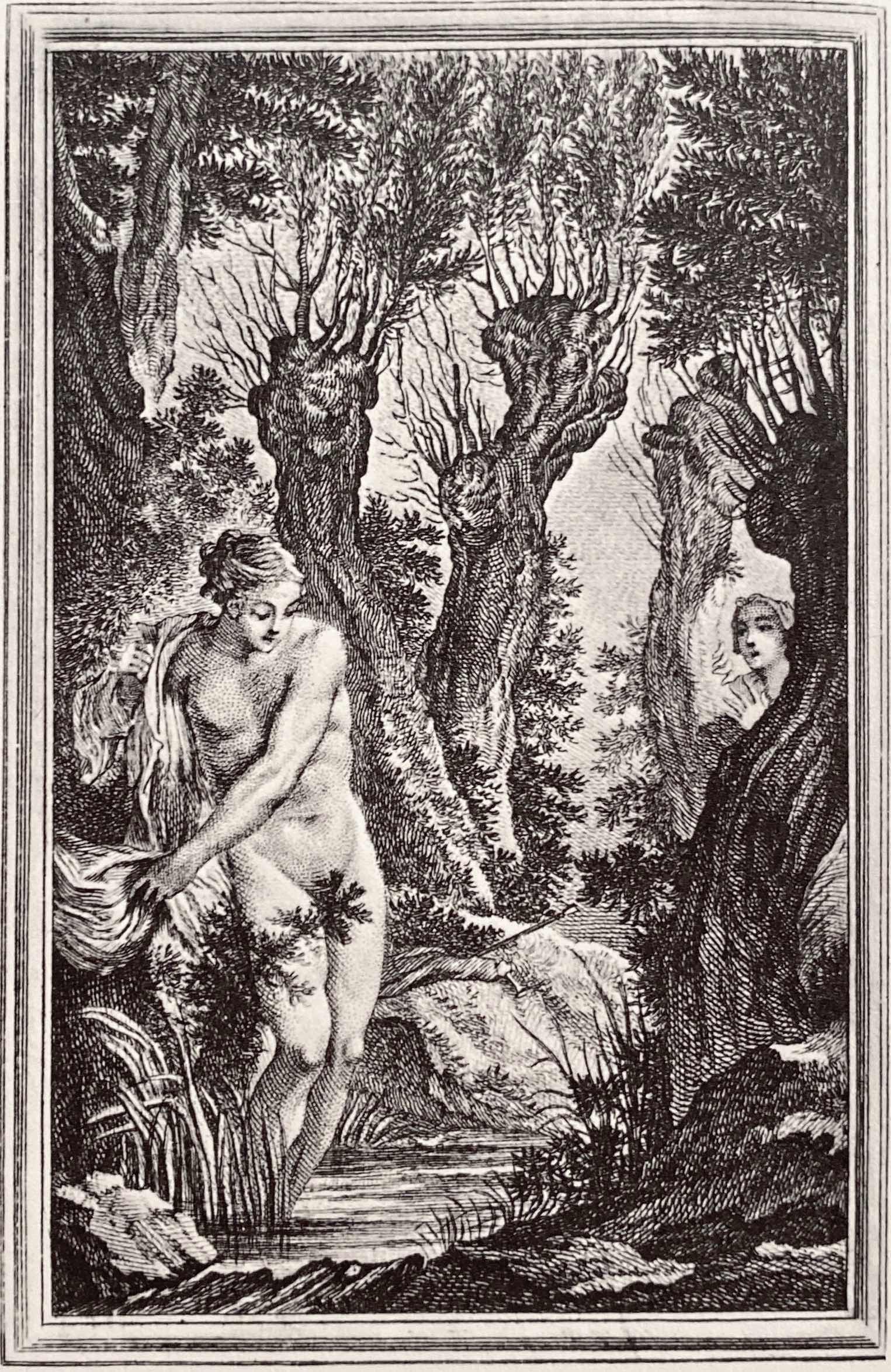 Contributors:
Jean de La Fontaine (French, 1621–1695) – author.
Fermiers généraux and Jean Baptiste Séroux d'Agincourt (French, 1730 – 1814) – publisher.
Joseph Gérard Barbou (French, 1723–1790) – printer.
Artists:
Charles Eisen (French, 1720 – 1778)
François Xavier Vispré (British-French, c.1730 – 1789 or after)
Hyacinthe Rigaud [Jacint Rigau-Ros i Serra] (Catalan-French, 1659 – 1743)
Engravers:
Joseph de Longueil (French, 1730 – 1792)
Noël Le Mire (French, 1724 – 1801)
Jean-Jacques André Le Veau (French, 1729 – 1786)
Jacques Aliamet (French, 1726 – 1788)
Jean Charles Baquoy (French, 1721 – 1777)
Pierre-Philippe Choffard (French, 1730 – 1809)
Jean Jacques Flipart (French, 1719 – 1782)
Louis Simon Lempereur (French, 1725 – 1796)
Jean Ouvrier (French, 1725 – 1784)
Contributors:
Jean de La Fontaine (French, 1621–1695) – author.
Fermiers généraux and Jean Baptiste Séroux d'Agincourt (French, 1730 – 1814) – publisher.
Joseph Gérard Barbou (French, 1723–1790) – printer.
Artists:
Charles Eisen (French, 1720 – 1778)
François Xavier Vispré (British-French, c.1730 – 1789 or after)
Hyacinthe Rigaud [Jacint Rigau-Ros i Serra] (Catalan-French, 1659 – 1743)
Engravers:
Joseph de Longueil (French, 1730 – 1792)
Noël Le Mire (French, 1724 – 1801)
Jean-Jacques André Le Veau (French, 1729 – 1786)
Jacques Aliamet (French, 1726 – 1788)
Jean Charles Baquoy (French, 1721 – 1777)
Pierre-Philippe Choffard (French, 1730 – 1809)
Jean Jacques Flipart (French, 1719 – 1782)
Louis Simon Lempereur (French, 1725 – 1796)
Jean Ouvrier (French, 1725 – 1784)
Étienne Ficquet (French 1719 – 1794)
Catalogue raisonné: Ray (French): №26, pp. 54-56; Cohen-DeRicci: 558-571; Lewine: 278-280. -
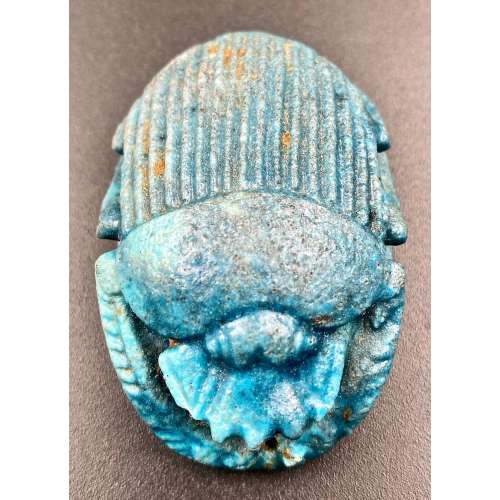 Egypt, Late Period. The oval amulet with multiple pierced holes for stitching to the outer garments of a mummy or the mummy wrappings, reeded wings and braided claws, marine blue in colour. According to the Brooklyn Museum, such faience amulets formed part of the beadwork pattern and served to protect the mummy through their magical properties. It served as a substitute heart that would ensure continued existence in the hereafter. A similar example at the Brooklyn Museum dated ca. 712-342 BC. Dimensions: 55 x 37 mm Provenance: The Collection of Erwin Harvith (1918 – 2011) and Sylvia Redblatt Harvith (1920 – 2015), Detroit, MI, acquired in 1972 directly from the Collection of Moshe Dayan, (משה דיין; 1915 – 1981), an Israeli military leader and politician. Exhibited: Jewish Museum, New York, NY, "Culture and Continuity – The Jewish Journey", 1975.
Egypt, Late Period. The oval amulet with multiple pierced holes for stitching to the outer garments of a mummy or the mummy wrappings, reeded wings and braided claws, marine blue in colour. According to the Brooklyn Museum, such faience amulets formed part of the beadwork pattern and served to protect the mummy through their magical properties. It served as a substitute heart that would ensure continued existence in the hereafter. A similar example at the Brooklyn Museum dated ca. 712-342 BC. Dimensions: 55 x 37 mm Provenance: The Collection of Erwin Harvith (1918 – 2011) and Sylvia Redblatt Harvith (1920 – 2015), Detroit, MI, acquired in 1972 directly from the Collection of Moshe Dayan, (משה דיין; 1915 – 1981), an Israeli military leader and politician. Exhibited: Jewish Museum, New York, NY, "Culture and Continuity – The Jewish Journey", 1975. -
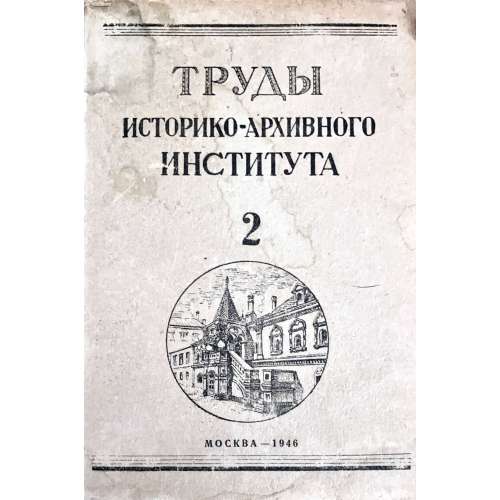 Елизавета Николаевна Данилова. "Завещание" Петра Великого / Под ред. Александр Игнатьевич Андреева. // В сборнике: Труды Историко-архивного института, том 2, 1946. (Кафедра вспомогательных исторических дисциплин). – с. 202-270. Москва: Главное архивное управление МВД Союза ССР. Историко-архивный институт, 1946. Тираж: 3000 экз.
Елизавета Николаевна Данилова. "Завещание" Петра Великого / Под ред. Александр Игнатьевич Андреева. // В сборнике: Труды Историко-архивного института, том 2, 1946. (Кафедра вспомогательных исторических дисциплин). – с. 202-270. Москва: Главное архивное управление МВД Союза ССР. Историко-архивный институт, 1946. Тираж: 3000 экз.


